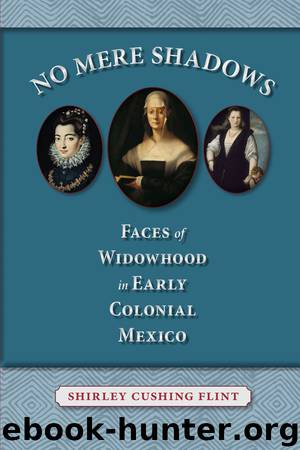No Mere Shadows by Shirley Cushing Flint

Author:Shirley Cushing Flint [Flint, Shirley Cushing]
Language: eng
Format: epub
Publisher: University of New Mexico Press
Published: 2013-10-15T04:00:00+00:00
Figure 4.1. Signature of doña Francisca de Estrada. Source: AGI, Escribanía de la Cámara 163B, N.10, Pieza 1.
CHAPTER FIVE
DOÑA BEATRIZ DE ESTRADA CHOOSES PRAYER
She [doña Beatriz] kept busy, completely giving herself to God with such severe penitence and the rigor of the spiritual life, that she was equal there [in the convent] to the most perfect young people, spending the little income that remained to her in the sustenance of the poor and in works of charity.
—Alonso Remón, 1617
The 1545–1563 proceedings of the Council of Trent reinforced the ecclesiastical tradition that strongly urged widows to remove themselves from society, adopt the sequestered life in either a convent or a lay house, and devote themselves to the quiet contemplation of God. Doña Beatriz, however, came from a family tradition of independent widows, and although she chose to remain unmarried and devoted to the church, she also successfully conducted her family’s affairs outside the church’s prescribed vision of a widow’s role in society. Her dual activities mirrored internal conflicts in the post-Tridentine era of church doctrine, which was caught between active participation in the outside world and enforced enclosure.1
Although doña Beatriz de Estrada chose a more secluded widowhood than her mother or sisters, she still appears in the documentary record conducting business related to her properties and encomiendas. She, too, found it necessary to continue her mother’s legacy of protecting the only form of wealth and status the family enjoyed—that of property owners. Doña Beatriz, like her mother and sisters, took seriously her responsibilities as guardian of her underage children, arranging prestigious marriages for them, appealing through the legal system for protection of widows and orphans, and increasing the value of her children’s inheritance. Yet with all these demands on her time and energy, she still found opportunities to practice her chosen religious vocation. The idea that as a lovely young widow she might remarry apparently held no charm for her. Her story is emblematic of another option exercised by independent widows in sixteenth-century New Spain, a life of religious devotion.
Download
This site does not store any files on its server. We only index and link to content provided by other sites. Please contact the content providers to delete copyright contents if any and email us, we'll remove relevant links or contents immediately.
| Civilization & Culture | Expeditions & Discoveries |
| Jewish | Maritime History & Piracy |
| Religious | Slavery & Emancipation |
| Women in History |
Cecilia; Or, Memoirs of an Heiress — Volume 1 by Fanny Burney(32080)
Cecilia; Or, Memoirs of an Heiress — Volume 3 by Fanny Burney(31471)
Cecilia; Or, Memoirs of an Heiress — Volume 2 by Fanny Burney(31422)
The Secret History by Donna Tartt(18232)
Sapiens: A Brief History of Humankind by Yuval Noah Harari(14000)
Leonardo da Vinci by Walter Isaacson(12819)
The Radium Girls by Kate Moore(11641)
Sapiens by Yuval Noah Harari(5131)
How Democracies Die by Steven Levitsky & Daniel Ziblatt(4972)
The Wind in My Hair by Masih Alinejad(4853)
Homo Deus: A Brief History of Tomorrow by Yuval Noah Harari(4695)
Endurance: Shackleton's Incredible Voyage by Alfred Lansing(4519)
Man's Search for Meaning by Viktor Frankl(4300)
The Silk Roads by Peter Frankopan(4278)
Millionaire: The Philanderer, Gambler, and Duelist Who Invented Modern Finance by Janet Gleeson(4117)
The Rape of Nanking by Iris Chang(4027)
Hitler in Los Angeles by Steven J. Ross(3803)
Joan of Arc by Mary Gordon(3797)
The Motorcycle Diaries by Ernesto Che Guevara(3796)
